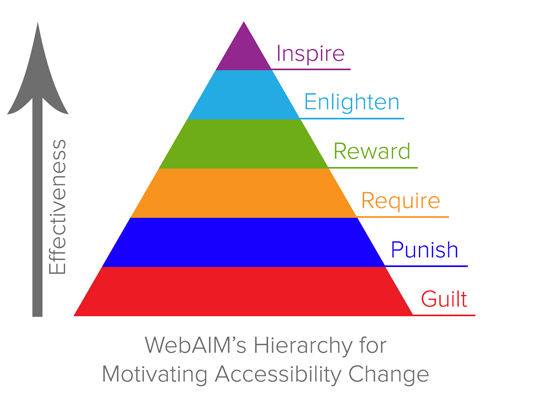“When you incent, people optimize for reward. When you inspire, people optimize for purpose.”
– Michael Norton
This quote, tweeted by Joseph O’Connor a couple weeks ago, caused me to consider the things that best motivate people to implement accessibility. We at WebAIM spend at least as much time motivating for change as we do educating on implementation details. I’ve compiled my thoughts into WebAIM’s Hierarchy for Motivating Accessibility Change:

The lower elements of this hierarchy are not necessary or even useful for effective motivation, but they are usually the most commonly used.
Guilt
Guilt is the worst motivator. It typically involves a trite tweet with a #FAIL hashtag or a “If you cared about people with disabilities, you would…” comment. Guilt is, unfortunately, the easiest motivator to use. Constructive, positive criticism and recommendations take time and effort, but are much more effective. See Christian Heilmann’s Drive-by Criticism Must Die.
Punish
“Be accessible or you’ll get sued” and “If your site is not fully accessible, we’ll boycott your company” are common methods of using punishment to motivate accessibility. The results are that people inevitably do the minimum amount possible to avoid punishment rather than building truly accessible products.
Guilt and punishment are the most dangerous motivators because they can easily cause people with disabilities to be viewed as enemies and antagonists, rather than beneficiaries of and potential contributors to accessibility.
Require
While technical requirements, guidelines, and laws can improve accessibility and are often a necessary foundation for more effective motivations, they generally define a low bar that often overlooks the human element of accessibility. Something can be technically accessible, but functionally an accessibility nightmare. Requirements focus on instances of accessibility compliance and rarely on the broader user experience and outcomes. They lack proper information and motivation to do much beyond meeting the minimal requirements.
No matter how much one might want it to be a technical issue, accessibility will always be a human issue.
Reward
Gamification, awards, certification statements, web site badges, and similar can bring about change, but the goal is often the personal reward and recognition, not the resulting benefit for end users. Sometimes the reward is simply knowing that you are expanding your market to a broader population of individuals with disabilities. These can motivate accessibility, but typically only so long as the rewards are tangible.
Enlighten
When one personally sees accessibility as the right thing to do and the smart thing to do, they are motivated for good. They will see the powerful benefits that accessibility provides to end users generally and to the design/development process – better design, cleaner semantic code, higher search engine rankings, better browser compatibility, etc. They make things accessible because doing anything otherwise just doesn’t make sense.
Inspire
Few things motivate people to make things accessible as well as inspiration. This occurs when you see and experience the distinct impact the accessibility (or lack thereof) of your product can have on the lives of an individual with disabilities.
Important
This does not suggest that this inspiration would or should come from individuals with disabilities. It is not the role of those with disabilities to inspire or motivate you to provide them equitable experiences. The proper type of inspiration comes from an internal desire to make a difference.
Beyond the reward of reaching an expanded market, you understand that your accessible product can have a profound influence. When inspired, you strive for the most accessible product not only because it matters to your users, but because it matters to you.

Excelent Jared! I loved your text, sometimes is difficult to find the perfect motivation/ word to call people for accessibility. your text inspired me ! thank you .
Lucy Gruenwald. ( from Brazil)
And then you wake up in Ontario Canada and realize none of it works.
I agree that this hierarchy of approaches should be sought, that is, try to start at the most positive, top level, and then go down as a subsequent resort. We should keep in mind, however, that people who feel that they have been oppressed by discriminatory practices for years, may naturally express displeasure in ways that expose their emotional upsetedness with the situation. Let us not blame the victim for not knowing or being skilled in the most effective persuasion techniques.
Hi Jamal
I agree to a point, with all du respect to some, they should read some of the articles at http://www.aoda.ca , these Governments types are thumbing their noses at accessibility of all kinds and the person writing about them is one of the most balanced and mild mannered Advocate you’ll ever meet, in one instance he had to take them to Court because being the nice guy didn’t work, he won the battle yet here he is yet again spearheading the fight for basic accessibility rights, in this most recent case pdf accessibility.
Some people take to the carrot and stick still others need to be beaten over the head with the stick and have the carrot shoved….
for those of us who have been dealing with this for years I’ll bet you know right off the bat what technique to use.